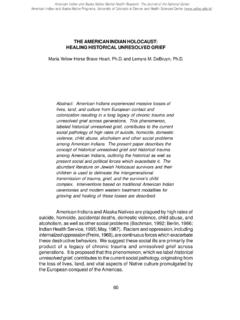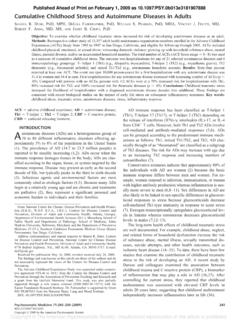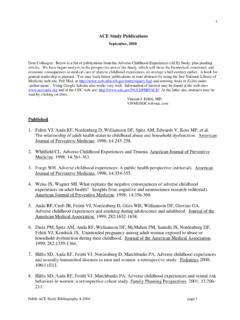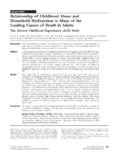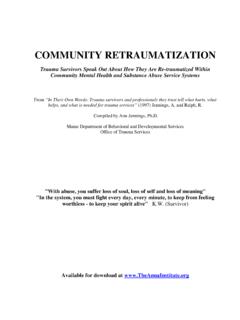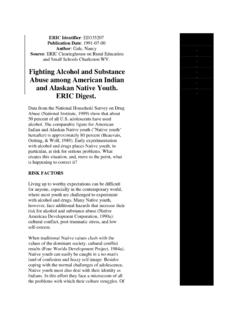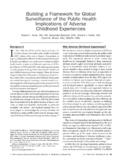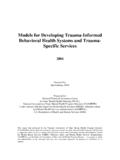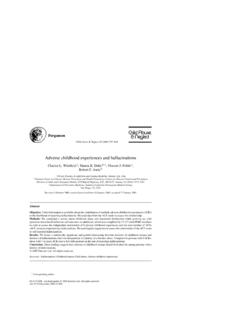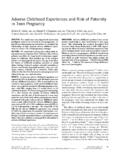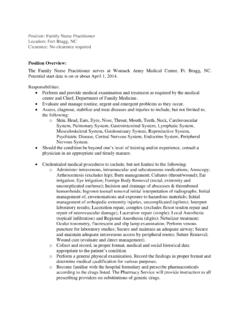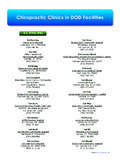Transcription of Acceptability of Adverse Childhood Experiences …
1 MILITARY MEDICINE, 173, 9:853, 2008 Acceptability of Adverse Childhood Experiences Questions forHealth Surveillance in Armed ForcesRonnie Robinson, MS*; Jamie D. Davis, PhD*; LTC Mary Krueger, MC USAf;Kristie Gore, PhD*t; Michael C. Freed, PhD*t; Phoebe Kuesters, BA*; Shanta Dube, PhD MPH ;COL Charles C. Enget, MC USA*tABSTRACT Background: Research has documented a consistent and strong association between Adverse childhoodexperiences (ACE) and negative health outcomes in adulthood. The Department of Defense is expanding healthsurveillance of military members and considering the inclusion of ACE questions. Objective: To explore the perceptionsand attitudes of service members and spouses regarding the use of ACE questions in routine health surveillance. Method:Forty-one active duty service members and spouses were interviewed at two Army troop medical centers.
2 Semistruc-tured qualitative interviews were used to examine their views regarding the use of ACE questions in military healthsurveillance. Results: Participants believe there is value in health surveillance; however, they are cautious aboutproviding ACE or other information that may be perceived negatively, without confidentiality reassurances. Conclusion:Successful employment of ACE questions in active duty military health surveillance wiil depend on the ability ofmilitary health oflficials to ensure confidentiality and to communicate the relevance of ACE to health has been an increasing recognition and interest in theuse of active health surveillance in the military since the1991 Persian Gulf War, and there has been wide interest andcautious enthusiasm in extending these eiForts to adversechildhood Experiences (ACE) and broader mental health do-mains.
3 The 2005 National Defense Authorization Act (Sec-tion 733, Baseline Health Data Collection Program) man-dated that the Department of Defense implement a baselinehealth assessment to improve health surveillance, facilitateunderstanding of how military-related stress and environmen-tal exposures affect future health, and contribute to a systemthat supports early intervention and prevention programsamong service members throughout their careers'. For thepurpose of this article, we define military health surveillanceas the routine systematic collection, analysis, interpretation,and reporting of population-based data in an effort to char-acterize and counter threats to the military population'shealth, well-being, and performance. If properly imple-mented, such surveillance efforts promise to offer key advan-tages such as the ability to monitor the overall health ofservice members and to identify emerging medical concerns, Deployment Health Clinical Center (DHCC), Walter Reed Army Med-ical Center, 6900 Georgia Avenue NW, Building 2, Room 3E01, Washing-ton, DC ot" Family Practice, Womack Army Medical Center, FortBragg, Building 2817, Room A10480-1, Fort Bragg, NC 28310.
4 ^Department of Psychiatry, Uniformed Services University of the HealthSciences, 4301 Bridge Road, Bethesda, MD of Adult and Community Health, National Center for ChronicDisease Prevention and Health Promotion, Centers for Disease Control andPrevention, 4770 Buford Highway NE, MS K-40, Atlanta, GA manuscript was received for review in July 2007. The revisedmanuscript was accepted for publication in June allowing for the development of programs and strat-egies to address emerging health of Adverse ChildhoodExperiences (ACE)ACE are commonly reported among military personnel, andare relevant health surveillance considerations, even if theyare not regularly and systematically assessed. Rosen andcolleague^'^ found that the prevalence of Childhood physicaland sexual abuse in Army recruits was 56% for males and66% for females.
5 A study of incoming Navy recruits foundthat 57% of female incoming Navy recruits reported child-hood physical or sexual abuse."* The same investigators ex-amined Childhood exposure to domestic violence as well aschildhood physical and sexual abuse among incoming Navyrecruits and found 51% of men and 61% of women reportedone or more of these ACE.''^In a community population, the Centers for Disease Con-trol (CDC) ACE Study examined the impact of seven cate-gories of Childhood traumatic stress which included sexual,physical, or emotional abuse, neglect, witnessing domesticviolence, living with a substance abuser or individual with amental illness, or having a criminal in the household on thehealth status of over 17,000 adult respondents seeking well-ness-based care through a large Health Maintenance Organi-zation.
6 '' Prevalence estimates from this study for categories ofchildhood abuse, neglect, and household dysfunction are sim-ilar to other national estimates from retrospective reports. Forexample, a national survey of adults conducted by Finkelhoret al.^ determined that 16% of men and 27% of women hadbeen sexually abused during Childhood ; in the ACE Studycohort, 16% of men and 25% of women in the sample hadexperienced Childhood sexual abuse. The ACE Study re-ported that 30% of the men had been physically abused asMILITARY MEDICINE, Vol. 173, September 2008853 Acceptability of ACE Questions for Health Surveillanceboys; this closely parallels the prevalence of 31% found in apopulation-based study of Canadian men.' ACE tend to co-occur. The ACE Study found that participants reporting onetype of ACE had a 90% likelihood of having also experienceda second type.
7 '"Health Impact of ACER esearchers have found strong and consistent associationsbetween multiple interrelated ACE and increased likelihoodof substance abuse,'""" smoking-related illnesses,' high-risksexual behavior,''''"'^ suicide attempts,''^-" depression,'*-"and other leading causes of death.'In the CDC studies,'-""" an ACE score was developed toexamine the possible cumulative effects through a total countof these Experiences . Using the ACE score, researchers havereported a dose-response relationship between ACE and neg-ative health. Eor example, Felitti et al.' reported that anindividual reporting two, three, and four ACE was at two,five, and nine times greater risk, respectively, for a suicideattempt. Individuals reporting four or more ACE, comparedto those reporting no ACE, had a 4- to 12-fold increase in riskfor alcoholism, drug abuse, and depression; a 2- to 4-foldincrease in smoking, poor self-rated health, and sexuallytransmitted disease; and a to increase in physicalinactivity and severe obesity.
8 ' The number of categories ofACE also showed a graded relationship to the presence ofdiseases including isch mie heart disease, cancer, chroniclung disease, skeletal fractures, and liver disease.' Similarfindings by Rodgers et al.^" evidenced a graded relationshipbetween the number of types of ACE and substance use andhigh-risk sexual , direct comparisons of CDC and militaryfindings may not be valid, because the CDC ACE Studyassessed seven types of ACE while military studies assessedfewer ACE types, creating issues of possible category over-lap. In addition, different questions and assessment method-ologies were employed in the CDC ACE Study versus mili-tary studies. That said, studies of military personnel suggestthat service members reporting ACE are at increased risk fornegative health outcomes similar to those identified in theCDC ACE Study.
9 ''-^'-^^ Findings from longitudinal studiessuggest that new military recruits who report Childhood sex-ual abuse are significantly more likely to leave military ser-vice during basic training^^-^" and during their first militaryenlistment ( , the first 4-year service tour) as compared tomilitary recruits not reporting theseAcceptability of Collecting ACE Data inthe MilitaryIt is clear that ACE are associated with a multitude of prox-imal and distal health consequences at the population level,but not at the individual level.^^ In Department of Defense(DoD) efforts to maximize force health protection and readi-ness,-^* ACE and mental health data collected as part ofroutine military health surveillance may help to identify in-dividuals with unmet needs and enable the development oftargeted health care and community-based programs designedto meet those needs.
10 However, as discussed in Rosen andMartin,^ military participants were uncomfortable disclosingACE information, even when confidentiality could be as-sured. It seems that the potential utility of asking such inva-sive questions as part of a thorough medical screening mustbe weighed against the possibility of untruthful responses andthe discomfort the questions may cause to the 2005, Dr. William Winkenwerder, the Assistant Secre-tary of Defense for Health Affairs at that time, asked theArmed Forces Epidemiological Board to discuss and providerecommendations about assessing ACE as a population met-ric in the military. The board concluded that merely askingthe questions about ACE could have deleterious effects,warned that health surveillance data may not be subject to thesame confidentiality limitations as military medical records,and without a clearly defined use for the data, asking ques-tions about ACE in a health surveillance context was notrecommended.
